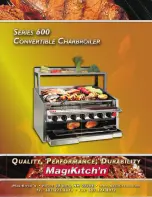
P-K SOLIS™
Gas Fired Boiler
Technical Service 1.877.728.5351
Revised: March 15, 2021
Released: March 15, 2021
Patterson-Kelley 2021
All Rights Reserved.
2701000090 P-K SOLIS NURO Installation and
Owners Manual (Rev A).docx
Page 39
3.6 Removing an Existing Boiler
When an existing boiler is removed from a common venting
system, the common venting system is likely to be too large
for proper venting of the appliances remaining connected to it.
At the time of removal of an existing boiler, while the other
appliances remaining connected to the common venting
system are not in operation, the following steps should be
followed with each appliance remaining connected to the
common venting system placed in operation:
1. Seal any unused openings in the common venting
system.
Sceller toutes les ouvertures non utilisées du système
d'évacuation
2. Visually inspect the venting system for proper size and
horizontal pitch and determine that there is no
blockage or restriction, leakage, corrosion or other
deficiency which could cause an unsafe condition.
Inspecter de façon visuelle le système d'évacuation
pour déterminer la grosseur et l'inclinaison horizontale
qui conviennent et s'assurer que le système est
exempt d'obstruction, d'étranglement, de fuite, de
corrosion et autres défaillances qui pourraient
présenter des risques.
3. Insofar as is practical, close all building doors and
windows and all doors between the space in which the appliance remaining connected to the
common venting system are located and other spaces of the building. Turn on clothes dryers
and any appliances not connected to the common venting system. Turn on any exhaust fans,
such as range hoods and bathroom exhausts, so they will operate at maximum speed. Do not
operate a summer exhaust fan. Close fireplace dampers.
Dans la mesure du possible, fermer toutes les portes et les fenêtres du bâtiment et toutes les
portes entre l'espace où les appareils toujours raccordés au système d'évacuation sont installés
et les autres espaces du bâtiment. Mettre en marche les sécheuses, tous les appareils non
raccordés au système d'évacuation commun et tous les ventilateurs d'extraction comme les
hottes de cuisinière et les ventilateurs des salles de bain. S'assurer que ces ventilateurs
fonctionnent à la vitesse maximale. Ne pas faire fonctionner les ventilateurs d'été. Fermer les
registres des cheminées
4. Place the appliance being inspected in operation. Follow the lighting instructions. Adjust the
thermostat so that the appliance will operate continuously.
Mettre l'appareil inspecté en marche. Suivre les instructions d'allumage. Régler le thermostat
de façon que l'appareil fonctionne de façon continue.
5. Test for spillage at the draft hood relief opening after 5 minutes of main burner operation. Use
the flame of a match or candle or smoke from a cigarette, cigar or pipe.
Faire fonctionner le brûleur principal pendant 5 min ensuite, déterminer si le coupe-tirage
déborde à l'ouverture de décharge. Utiliser la flamme d'une allumette ou d'une chandelle ou la
fumée d'une cigarette, d'un cigare ou d'une pipe.
NOTE:
The instructions shall include the
test procedure set forth below:
At the time of removal of an existing
boiler, the following steps shall be
followed with each appliance
remaining connected to the
common venting system placed in
operation, while the other
appliances remaining connected to
the common venting system are not
in operation.
Les instructions doivent
comprendre le mode opératoire
d'essai indiqué ci-dessous: Au
moment du retrait d'une Chaudière
existante, les mesures suivantes
doivent être prises pour chaque
appareil toujours raccordé au
système d'évacuation commun et
qui fonctionne alors que d'autres
appareils toujours raccordés au
système d'évacuation ne
fonctionnent pas.
















































